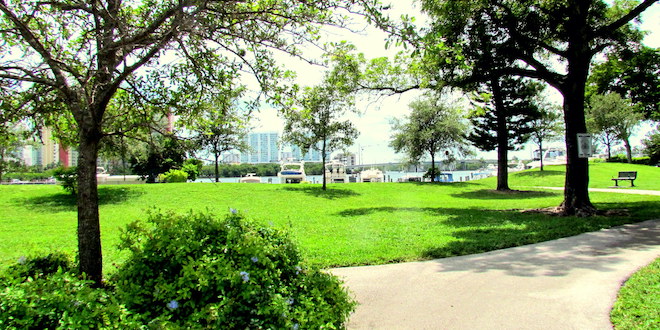Pesticides, herbicides, and fertilizers should be applied sparingly, not exceeding manufacturer’s directions. When handling potential harmful materials such as fertilizers, herbicides, and pesticides, use efficient and safe storage and cleanup methods. Fertilizer management involves control of the rate, timing, and method of application to minimize the chance of polluting surface water or groundwater. Always store in a dry area free from rainfall.
Proper Use
- A good rule of thumb when applying is “less is best” to protect the environment
- Never apply near waterways or before a forecasted heavy rain event. Instead of helping them soak, rain will wash any products from your property
- Never pour any of these chemicals down any drain in your home or storm drain
- Store pesticides in their original containers with original labeling, in a dry area free from rainfall
- Read the label, follow the instructions, and use the minimum recommended application
- Only apply to grassy or landscaped areas. Driveways and sidewalks (impervious areas) should be avoided at all costs.
Disposal
To dispose of unused, leftover, or unwanted pesticides, herbicides, or fertilizers, bring them to the Miami-Dade County Home Chemical Collection Centers at 8801 NW 58 Street, Doral, FL 33178 and 23707 SW 97th Ave, Homestead, FL 33032.
Glyphosate
Glyphosate is the active ingredient in the well-known herbicide Roundup. A study by the World Health Organization’s International Agency for Research on Cancer found that it is a probable carcinogen. It may also be a potentially harmful environmental pollutant. The City of Sunny Isles Beach does not use glyphosate in our parks or on public properties we maintain. We encourage our condominiums and homeowners to work with us to protect our local environment by eliminating the use of glyphosate.
Florida-friendly Landscapes
Florida-friendly landscapes (FFL) help to reduce the need for pesticides, herbicides, and fertilizers by encouraging residents and business owners to create and maintain beautiful yards using research-based, environmentally-sustainable landscaping practices. Proper implementation of the nine FFL principles in your yard will protect the natural environment around us for future generations to enjoy. More information can be found at: https://ffl.ifas.ufl.edu/.
- Right plant, right place – choosing low-maintenance plants to match conditions in your landscape can help them thrive with little or not irrigation and few or no fertilizers and pesticides.
- Water efficiently – overwatering plants makes them more prone to disease and pests, and can cause water pollution via leaching (when more fertilizer is applied to a landscape than plants can absorb, or when heavy rains and overwatering cause nutrients to travel quickly through soils and into groundwater)
- Fertilize appropriately – before using fertilizers, always determine if its really needed. Choose slow-release products, use sparingly, and know how much and when to apply. Never fertilize near a waterbody or before a heavy rain.
- Mulch – this can protect plants, reduce soil erosion, improve soil, and inhibit weed germination and growth.
- Attract wildlife – reduce insecticide use that kill many beneficial insects that deliver key services to your garden and surrounding landscape and reduce the amount of mowed lawn area.
- Manage yard pests responsibly – Integrated Pest Management (IPM) helps prevent and manage pest problems with as few chemicals as possible. IPM emphasized smart planning, proper maintenance, and natural or low-toxicity controls in ensuring plants stay healthy and resist insect infestations or disease infections. Start with low-impact techniques, avoid using broad-spectrum insecticides, and spot-treat only. Apply pesticides during the cooler part of the day, and use products only on recommended plants.
- Recycle yard waste – adding composted material (from moving, pruning, raking) to soil recycles valuable nutrients.
- Reduce stormwater runoff – keep rain that falls in your yard in the ground by planting rain gardens, using porous surfaces, creating swales or berms, and aiming downspouts into porous surfaces.
- Protect the waterfront – Waterfront property owners should establish a buffer, known as the riparian zone, of vegetation to protect shoreline. Other man-made structures such as seawalls and rip rap also minimize erosion. Do not let grass clippings or fallen tree leaves get washed into the water body. Pick up all pet wastes deposited on your landscape. Before building anything on your property, make sure you contact the FDEP or your local city or county offices related to land development, building, and planning.
 City of Sunny Isles Beach Official Website
City of Sunny Isles Beach Official Website
